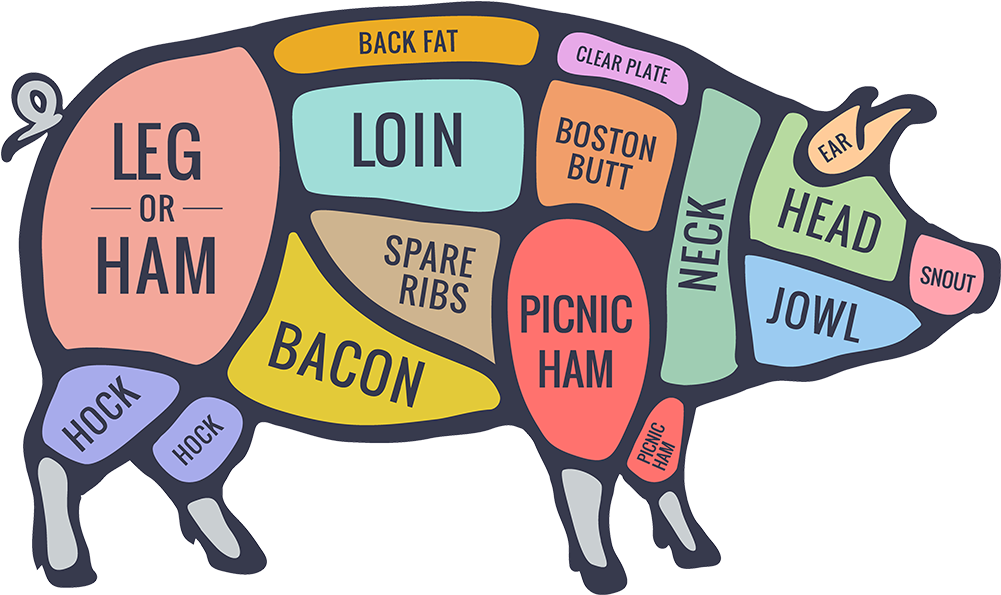Global meat consumption is increasing steadily with the concurrent rise in human population. Among meat products, pork has been maintaining its position in the top two of meats consumed.
According to a report by The Organisation for Economic Co-operation and Development in 2022, pork was the second most consumed type of meat after poultry. Global pig meat consumption is projected to increase to 129 metric tonnes over the next ten years and will account for a third of the total increase in meat consumption.
The top consumer of pork in 2021 was China, taking into account its special economic regions Hong Kong, Macau, and Mainland China, whose consumptions were about 61, 52, and 37 kg/ inhabitant per year respectively. In second place, we have Belarus, then the European Union, South Korea, and Vietnam in the third, fourth, and fifth place.
Most of the pork for consumption comes from five main parts of a pig: the shoulder butt; the picnic shoulder; the loin; rib belly and the ham (leg).
The shoulder butt consists of cuts from the upper portion of the well-exercised front legs of the pig and tend to be tough, with a fair amount of fat. The picnic shoulder, the economical arm, or arm shoulder, has characteristics similar to the shoulder butt. Shoulder hocks also come from this part of the pig.
The loin, the area between the shoulder and the leg, is divided into some of the most popular cuts, including pork chops, tenderloin, roasts, and ribs. This area is lean. The rib belly, the side, or “belly,” of the pig is the fattiest part and is home to spareribs and bacon. Lastly the ham, also referred to as the leg, can be cured, prepared as a roast, bone-in or spiral sliced.

(Image source: pexels.com by Evgeniy Alekseyev)
Common pork products include bacon, ham, lard, pork fu/pork sung, pork rinds (chicharrones), salt pork, salo, guanciale, hog jowl, pancetta, and salami. Bacon is basically cured, smoked, and sliced pork belly.
A cut of pork from a pig’s hind leg is known as ham. Varieties of ham include cured ham, fresh ham, country ham, Black Forest ham, and hickory-smoked ham. A bone-in, whole ham is a full cut from the hind leg of the pig. Ham is preserved either through brining (also known as wet curing) or traditional dry curing with seasonings like salt.
Lard is a semi-solid white fat product obtained by a process called rendering, whereby the fatty parts of the pig (such as the belly, butt, and shoulder) are cooked slowly until the fat is melted and the fat is then separated from the meat.
Pork fu is porkshoulder cooked with other ingredients and spices, such as soya sauce, sugar, or fish sauce. After that, it is shredded to a fine texture known as pork fu which is then dried in the oven or in a hot pan or wok so that it can last longer. Pork sung, also called rousong, is prepared in the same way. The main difference between the two is that pork fu is slightly more airy and pork sung is more dense and intense in flavour.
Pork rinds (chicharrones) are prepared frying pork belly or fried pork rinds. Salt pork is salt cured pork belly, the same as bacon but not smoked, and with the skin on.
Salted cured pork fat back is known as salo. It may be brine cured or dry salt cured, and it usually has a layer of skin, and sometimes a thin layer of meat on the other side. It is sometimes cured with salt and paprika or smoked.
Guanciale is pork jowl (cheeks) rubbed with salt, sugar, and spices to give it a non-smoked cure. Pancetta is pork belly rolled up into a cylinder and given a salt cure, but it is not smoked.

Cold pork meats. (Image source: mentalfloss.com)
Cured sausage consisting of fermented and air-dried pork is referred to as salami. The meat is ground and kneaded to achieve the desired texture, and then various spices are added according to specific recipes. Pig parts consumed differ from culture to culture, as do their processing. The final product options coupled with globalisation promote the uptake of “new” products by people from anywhere across the globe providing an exciting journey their palates have never experienced.
As agribusinesses adapt, research and implementation of new processing techniques for pork add value to the product range of top pig producing companies such as the WH Group from China; CP Group from Thailand; Triumph Foods from the USA; BRF from Brazil, and NongHyup Agribusiness from South Korea. Consumers will have choices never before fathomed.

Pig carcasses hanging in cold room storage. (Image source: nationalhogfarmer.com)









